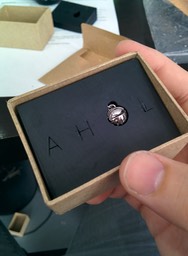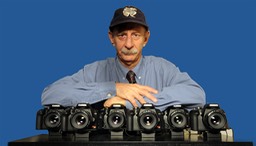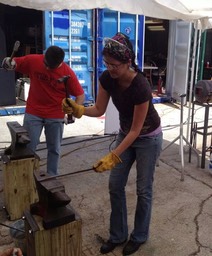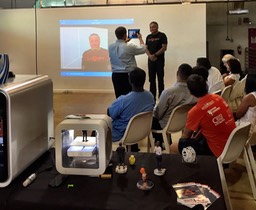Hear Alex de Carvalho, Mark Diamond and team of Moonlighter Cafe discuss their respective Maker experiences
Just about anyone can be a “maker.” What does a maker make? Robots, vases, “selfie” sculptures, palm frond hats, facial-recognition software and hot-forged garden tools. “And being able to share and teach someone else about the things you make is powerful,” said Jessica Mendez, a VISTA volunteer, teaching desktop design to teenagers through MIAMade, a non-profit tech facilitator and event producer.
A mashup of artists, educators, digital designers, craftworkers, scientists and engineers is fueling South Florida’s burgeoning Makers Movement. Makers spaces provide the venues for them to work and interact – for social benefit, for business development and for the sake of art that often serves both purposes.
LAB Miami, a 10,000 square foot co-working space, was co-founded in 2012 by Daniel Lafuente and Wifredo Fernandez. Located in Wynwood, it’s a key node in the region’s maker and startup community.
“First it’s a place for professionals to meet and network and learn from each other. Next, it’s a place for presentation of educational experiences,” said Fernandez.”
In Broward County, Makers Square provides tools, space and “over the shoulder” support. There are other ventures in various stages of development. Studio complexes like the Bakehouse, Fountainhead Studios, Fat Village and ArtCenter/South Florida provide shared presses, kilns, galleries and opportunities for interaction, but the makers concept prioritizes the communal functions.
The convergence of art and technology isn’t new. For centuries, artists have enlisted skilled artisans with specialized equipment to realize their bronze sculptures and prints. From early in the 20th century, artists’ tools and gear progressed from motors and projectors to radios, televisions and computers. Nor is the collaborative process a recent invention. Large Renaissance studios encompassed a master artist, journeymen, specialists and apprentices.
So what’s new? The convergence of team designing, the democratization of high-tech tools, open-source software, the proliferation of social media, crowd-funding and the hunger for hands-on experiences (Think Etsy and Lowe’s).
These have led to a variety of new models of creativity and lifestyle choices, as millennials explore alternatives to “getting a job” and baby boomers consider “what’s next.”
The makers phenomenon is worldwide. Magazines and blogs abound. President Obama hosted the first White House Maker Faire on June 18.
Two quick immersion experiences are on offer this week. Refresh Miami, a non-profit founded in 2006 to encourage local entrepreneurial and technical communities will present The Maker Movement on November 6 at 6:30 pm at Miami Dade College. Among the featured topics will be shared workspaces, 3D printing, robotics, drones, and mini-controllers.
Two days later, the second Miami Mini Maker Faire convenes in and outdoors. Presented by LAB Miami and MIAMade and also filling the Light Box next door, high and low-tech practitioners will compete for attention with products and services aimed at enthusiasts of all ages. Last year’s event included artists, robots, engineers, musical bananas, virtual reality demos, lots of 3D printing, advanced culinary experiments plus old-fashioned handcrafts. Approximately 90 presenters will engage an audience anticipated to reach nearly 3,000.
Scores of kids have been primed during tech camps for coding and guided through science experiments, including interaction with an orbiting mini satellite.
Arts advocates seek to enhance STEM (Science, Technology, Engineering and Math) learning with the addition of “A” for art. The huge popularity of gaming, video animation and animatronics provides a boost, and educators strive to shift the focus from playing games to making games.
During an October arts-focused hackathon at YoungArts’ new facility, Fernandez said, “We thought there’s a burgeoning tech community; there’s an increasingly strong arts community. How can you bring the two together? We pose the challenge to designers and technologists: ‘How can we improve the arts through technology?’” The Knight Foundation is a frequent funder of such initiatives. Participants compete to create apps featuring the discovery of art, the engagement with art or the creation of art. Winners get cash prizes; their works are promoted and they’re encouraged to make connections with prospective patrons. David Shaw and Randy Jarrin weren’t the winners, but were still gratified by the chance to compete. Over two days, they created the germ of an app that uses QR codes applied to artwork labels in galleries and museums to deliver information about the art and artists.
LAB Miami was initially funded by a Knight Foundation grant, but Fernandez said, “We’ve been sustainable since the fourth month. We’re a for-profit business with a social mission. Grant funding is finite; you cannot depend on it, so that’s been our thesis.”
Among the Lab’s entrepreneurs are Tom Pupo and Daisy Nopal, founders of Moonlighter. Recent FIU architecture graduates, the couple is developing a prototyping café/retail store where people can stop after work to have a coffee, chat and explore the world of design. “It’s about bridging the gap, so you don’t have to learn something completely new to actually develop a product that’s really elegant,” said Pupo. As with digital cameras, 3D design/printing offers interfaces that range from select-and-print (see Thingiverse and other design sharing sites) to simple customizing menus to complete desktop design.
While selling local design products, the Moonlighter cafe will also offer its patrons tools to realize their own design ideas. Currently, Moonlighter invites guest designers to display their work/products/objects on the website, online store, and mobile app.
During Art Basel, they will partner with DesignLab to showcase garment designs that use 3D printed components and accessories. Teaching fashion design, sewing and “wearable technology” are all part of the DesignLab’s North Miami-based program. (see Herald story http://goo.gl/Fl8kvU)
All summer, the Moonlighter partners and Mendez have been at the LAB demonstrating software to adults and children, then printing their designs. Mendez said, "Kids being able to take these skills and make careers out of them is really important. Like, you can make this into something you do all the time."
Sandra Canning is a photographer and recent convert to 3D printing. “This is our version of the personal computing revolution. This is going to change everything, and I refuse to be the last person to learn how to do it.” This summer, she started a Meetup group focused on 3D printing, which now has 150 members. Events, held both at LAB Miami and as cocktail mixers, feature exhibitions, music and equipment demos, including Forge 3D Printing Studio founders, who scanned volunteers rotating on a turntable to produce “3D selfies” – lifelike statuettes. Alex de Carvalho, Knight Foundation Innovator in Residence at Florida International University was only partially kidding when he said, “They're playing to people’s narcissism, and this is one of the most narcissistic cities, so definitely they could have a little shop here.” He had to be there to get his.
Werner and Alfredo Blumenthal of WB Engineering, were running several 3D printers. They have been stalwarts in demonstrating the capabilities of the technology to facilitate innovation in footwear design, architecture, jewelry-making, aerospace, telecommunications and medicine. Think kidneys, children’s “disposable” prostheses – and more selfies!
Artist Carol-Anne McFarlane graduated from Atlanta College of Art in 2005. Her studio is in the Lauderhill Art Center complex, and she’s inspired by the Coral Springs Art Museum’s monthly Knight-funded Digital Art Salon, which hosts accomplished artists from around the world. Her work often critiques women’s treatment in society. One series presents provocative silhouettes. Already adept with Adobe Illustrator, 3D printing brought her forward. “What does it mean now to turn them [the silhouettes] into a physical object? Next, she’s preparing to use the low relief surface of a coin shape to explore racial and gender bias through discriminatory pay scales.
Since the 1970s when he introduced the first holographic studio to Miami, Mark Diamond, has voraciously studied visual perception and experimented with advanced techniques of image capture and manipulation, including time lapse, stereography, laser holography, panoramic and aerial photography. Meteorologists, archeologists, modelmakers, sculptors, collectors, musicians and hair stylists are among his collaborators and clients. During the past two years, he has used multiple-camera arrays to create 3D lenticular images, exploring tiling, textures, geometries and extremes of spatial illusion. For decades, he has photographed Miami artists, and as the Wynwood Walls began attracting A-listers, they are now frequent subjects – often in action. Diamond has long maintained that, “It’s an art crime to photograph sculpture in anything other than 3D.”
Sri Prabha’s recent multi-media installation at the Art and Culture Center of Hollywood was inspired by his scientific bent and draws from telescopic imagery, microbiology and other natural phenomena. Sound artists – like filmmakers – often collaborate with programmers, videographers and musicians to realize projects connecting computer-generated sounds with acoustic music and environmental sampling. South Florida boasts a strong community of experimenters, who deserve their own story, as do the region’s environmental artists, whose work frequently relies on community engagement.
“There's yacht clubs for people with boats. There’s country clubs for people who play golf. Why can't there be a club for people who make stuff?” Jack McNulty is the co-founder – with partner Brian Weiner and wife Elaine Scantlen – of Makers Square near downtown Fort Lauderdale. The distinctive facility is a 14,000 square foot complex of indoor-outdoor, upstairs and downstairs spaces. Since opening in October 2013, the organizers and members have created zones and sheds for ceramics, electronics metalworking, jewelry, woodshop and fibers (Scantlen is a milliner). There are open spaces, sheds and areas for hanging out, gardening, projecting movies and staging workshops, like blacksmithing.
There are challenges. Each time someone joins, it takes McNulty a couple of hours to train them to use the equipment they’re interested in. Safety is primary, but also, “Otherwise it’s just “Ask jack! Ask jack! Ask Jack!” all day long,” he said. Makers Square has about 45 members. “Just like a health club, some people pay and they show up infrequently, while others are there six days a week. Often it’s a particular tool or workshop that will draw a prospective member, but it’s the community aspect that really provides the “glue.” Often members will come, not to work on their own projects, but to help colleagues. McNulty, a veteran of Burning Man, also calls his venture “a Moose Lodge for weirdos.”
“I think the number that works for makers spaces is 75 to 80 people. After that, you don’t know everybody.” They plan to expand, but slowly.
McNulty continued, “There's a huge group of us that are in a transition of careers. Maybe we had extremely digital careers where we sat down all day working in the corporate workspace and we didn't really have the feeling of completion and the satisfaction of doing something with your hands.” The transition can be difficult, however. Sometimes the thing we do for love loses luster when money becomes a motivator.
Having left an IT career, McNulty finds greater satisfaction in construction and tinkering in the robotics lab than he does with the 3D printers. He doesn’t see them as the game-changer. “It’s not like the Internet, where there was a before and after,” he said. He teaches children to work creatively with the new generation of micro-controllers and simplified computers – Arduino and Raspberry Pi. They’re kin to earlier generations’ radio kits and soapbox derby cars. He sees this as training for the “internet of things,” a world filled with objects capable of intercommunication – appliances, wearables, embeddables and the like.
Sandra Canning’s 3D photos are called lithophanes. They were popular in the 1800s, often used as lamps. By carving or molding a translucent material like frosted glass or porcelain, a relief image is revealed with backlighting. Production can now be done with a 3D printer or miniature milling machine. Canning partnered with a company that does rapid prototyping of aerospace parts. She explained her vision for their high level printer, and they said, “Wait a minute, you're saying that we can do art on these things? We usually do widgets! The results thrilled everyone. She’s now a proselytizer. “When you have your own creation that started out in your head and it was just some crazy idea, and then you're looking at it, and like oh my God, I had no idea I could do that!
She doesn't know if lithophanes will prove commercially viable, but says, “If there’s some bride somewhere that really wants a twelve by eighteen backlit picture of the most important day in her life, then you just sold a lithophane. It's just another way to print a photograph in a very high-tech way.”
Hear some of the makers’ voices at bitly.com/HeraldArtTechSocial



